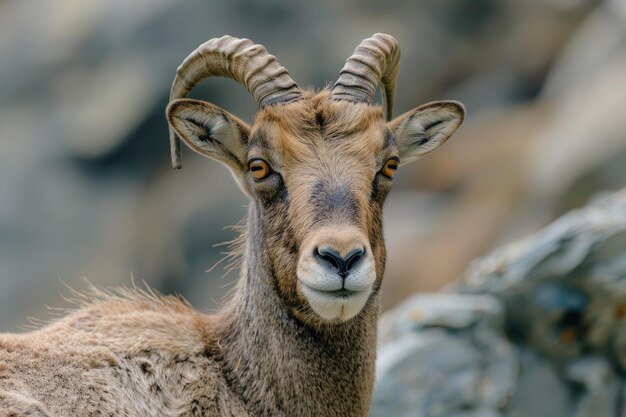
So, let’s dive into the world of the ibex and explore whether they are endangered, what challenges they face, and what conservation efforts are underway to help them. Think of this as a conversation over coffee where we unpack the complexities surrounding these fascinating creatures and their habitats.
Understanding the Ibex: A Brief Overview
The ibex belongs to the goat family and can be found in mountainous regions from Europe to Asia. With several species, such as the Nubian ibex and the Alpine ibex, each has adapted to its specific environment, showcasing unique characteristics. The Alpine ibex, for instance, can be spotted racing up steep cliffs, thanks to its incredible balance and climbing skills. Imagine watching a mountain goat prancing effortlessly while you struggle to climb even a small hill!
One of the most remarkable features of the ibex is its impressive horns. These can grow up to 3 feet long! They use them for defense against predators and during battles with other males during mating season. It’s not just a beauty pageant in the wild; there’s a fierce competition going on, much like a heavyweight boxing match, with the strongest ibex getting the chance to mate.
Unfortunately, as magnificent as they are, these animals face serious threats. Let’s take a closer look at why some ibex populations are struggling and what it means for their future.
The Threats to Ibex Populations
There are a few main reasons why ibex are finding themselves in trouble. First and foremost, habitat loss is a big factor. As humans expand into mountainous areas for development, the ibex lose their natural homes. It’s like if someone decided to build a shopping mall on your neighborhood park – suddenly, your favorite spots are gone.
Next up is climate change. Changes in temperature and weather patterns can make it difficult for ibex to find food and suitable habitats. Imagine trying to find your favorite ice cream shop on a hot summer day only to realize it’s closed for good; that’s what the ibex face with changing climates.
Lastly, we can’t forget about poaching. While it might seem unbelievable, some people hunt ibex for their horns, meat, or even trophies. This practice has dramatically reduced certain populations, leading to a decline that’s difficult to recover from. It’s like being in a race and having someone continuously knock you down; it’s hard to get ahead!
Current Status: Are Ibex Endangered?
The conservation status of ibex varies by species. Many ibex populations are classified as “Least Concern” by conservation organizations like the International Union for Conservation of Nature (IUCN). However, this doesn’t mean they are completely safe. Some species, like the Nubian ibex, are marked as Vulnerable due to their declining numbers and fragmented populations.
To put it plainly, while some ibex are doing okay, others are facing a race against time. It’s crucial for us to pay attention to their status and understand that conservation is a continuous effort. Think of it as a relay race: if one runner stumbles, the whole team struggles to finish and succeed.
Conservation Efforts for Ibex
Around the world, various conservation initiatives aim to protect ibex populations. One of the most effective strategies has been the establishment of protected areas. These are designated regions where ibex can roam and thrive without the threat of poaching or habitat destruction. Imagine having a protected zone where you can enjoy your hobbies without any interruptions or worries.
Another important approach is community involvement. Local populations are encouraged to participate in conservation efforts, educating them about the importance of preserving these creatures. This can lead to sustainable practices that benefit both the ibex and the communities around them. It’s like a collaborative neighborhood watch; everyone plays a part in keeping things safe.
Additionally, conservationists often engage in monitoring projects to keep track of ibex populations and their health. By gathering data, they can make informed decisions about the best actions to take. This is akin to a health check-up; you need to know your starting point before making any changes!
Success Stories: Recovery of Ibex Populations
Despite the challenges faced, there are some heartwarming success stories in the world of ibex conservation. The Alpine ibex is a prime example; their numbers have made a remarkable comeback thanks to concerted conservation efforts. Once teetering on the edge of extinction, their population is now thriving, particularly in Italy, thanks to protective laws and habitat restoration.
These success stories serve as a beacon of hope and remind us that when we come together to protect our planet’s creatures, change is possible. It’s a bit like the underdog team that pushes through the ranks to win the championship; perseverance pays off!
What You Can Do to Help
Feeling inspired to help the ibex? There are several ways you can make a difference.
- Support Conservation Organizations: Contributing to organizations dedicated to wildlife conservation can make a big impact. Just a little support can help fund projects that protect ibex and their habitats.
- Raise Awareness: Talk about ibex conservation with your friends and family. The more people know, the more we can collectively advocate for these animals.
- Visit Safely: If you ever find yourself in ibex territory, practice responsible tourism. Observe from a distance, respect their space, and make sure to leave no trace behind.
Every small action adds up, and together, we can help ensure that ibex continue to roam the mountains for generations to come.
So, is the ibex endangered? The reality is more complex than a simple yes or no. The conservation status varies by species, and while some are thriving, others desperately need our help. As we’ve discussed, habitat loss, climate change, and poaching continue to threaten these magnificent creatures. Yet, with ongoing conservation efforts and community involvement, there’s hope for recovery.
Remember, we all have a part to play in this story. Help save the ibex by spreading the word and supporting conservation efforts. After all, keeping our planet’s amazing biodiversity intact is a challenge worth tackling—together.

